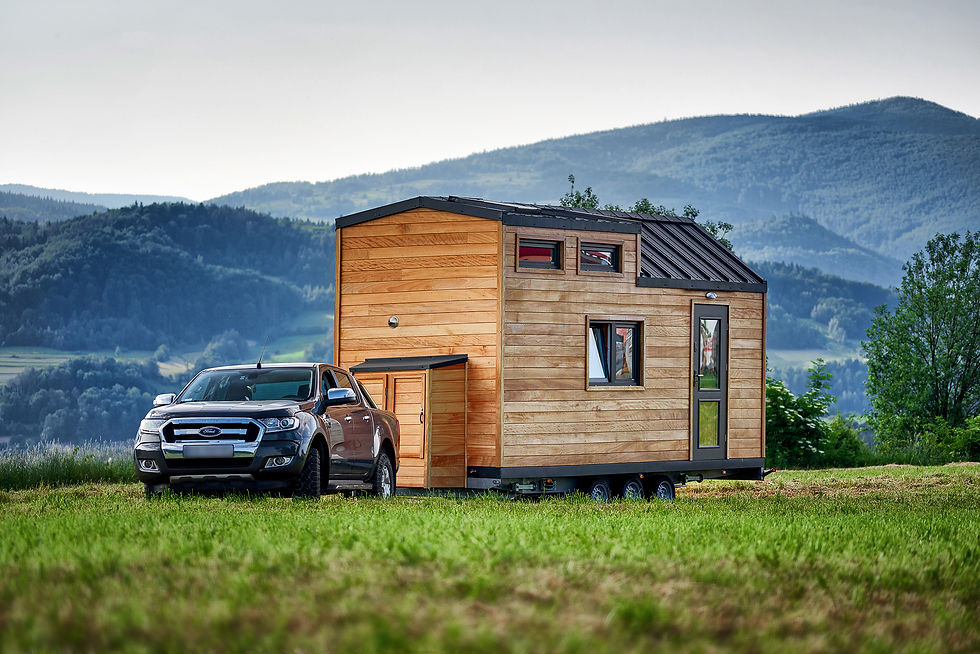Lofted Bedrooms vs. Ground Floor Sleeping in Tiny Houses: Finding Your Dreamy Sleep Space
- Vagabond Haven

- 26.9.2023
- 3 min käytetty lukemiseen

When you read this article, convincing you of the greatness of tiny houses may be stating the obvious. However, when it comes to choosing the perfect sleeping arrangement in a tiny home, the decision between a lofted bedroom and ground floor sleeping can be a critical one. These two primary choices for your resting space are one aspect that distinguishes one tiny home from another. Our Vagabond Haven models offer these various options, ranging from traditional raised lofts to mezzanines, to models without lofts altogether. In this article, we'll have a look at the pros and cons of each option, helping you make an informed choice for your dreamy sleep space.
Lofted Bedrooms: Reaching New Heights
Lofted bedrooms are a hallmark of tiny house design. They're typically located in elevated spaces, accessible via a ladder or staircase. Let's see the benefits and considerations of lofted bedrooms:
Pros of Lofted Bedrooms:
1. Maximizing Floor Space: Lofted bedrooms free up valuable floor space below, allowing for more open and flexible living areas. This additional space can be used for various purposes, from a cozy living room to a functional kitchen.

2. Privacy: Lofted bedrooms often feel more private as they're physically separated from the rest of the living space. This separation can be beneficial for those who prefer a quiet, dedicated sleeping area.
3. Enhanced Views: Depending on the placement of windows, lofted bedrooms can offer picturesque views and unique perspectives of your surroundings, creating a serene sleeping environment.
4. Cozy Atmosphere: The compact size of lofted bedrooms can create a snug and cozy atmosphere, ideal for those who enjoy the feeling of being enveloped in their sleeping space.
Cons of Lofted Bedrooms:
1. Accessibility: Climbing up and down a ladder or staircase can be challenging, especially for individuals with mobility issues or during nighttime bathroom trips.
2. Limited Headroom: Lofted bedrooms often have lower ceiling heights, which may not be suitable for taller individuals who may need to stoop or crawl in bed.
3. Heat and Ventilation: Lofted bedrooms can become warmer than the rest of the tiny house due to rising heat. Adequate ventilation and cooling are essential to ensure comfort.
4. Privacy Concerns: While some prefer the privacy of a lofted bedroom, others may find it isolating or claustrophobic.
Ground Floor Sleeping: Down to Earth Comfort
Ground floor sleeping arrangements place the bedroom on the main level of the tiny house, typically in a separate or semi-enclosed space. Let's explore the advantages and considerations of ground floor sleeping:
Pros of Ground Floor Sleeping:

1. Accessibility: Ground floor sleeping is easily accessible for people of all ages and physical abilities, making it a safer and more convenient option.
2. Ample Headroom: With a standard ceiling height, ground floor sleeping areas provide more headroom, offering greater comfort and ease of movement.
3. Temperature Control: Sleeping on the main floor allows for better temperature control, as heat rises and cool air remains closer to the ground. This can result in more consistent sleeping conditions.
4. Design Flexibility: Ground floor sleeping arrangements offer greater design flexibility, allowing for various layouts and furniture placement options.
Cons of Ground Floor Sleeping:
1. Reduced Living Space: Ground floor sleeping can occupy a significant portion of the main floor, potentially limiting the available living area in your tiny home.
2. Less Privacy: The sleeping area on the main floor may be less private compared to a lofted bedroom, which can be a consideration for some individuals.
3. Limited Views: Sleeping on the main floor may not offer the same elevated views as a lofted bedroom, potentially missing out on scenic surroundings.
4. Open Feel: Ground floor sleeping areas may have a more open and exposed feel, which may not appeal to those seeking a cozier sleeping environment.
Making Your Choice: Finding Your Dreamy Sleep Space
Choosing between a lofted bedroom and ground floor sleeping ultimately depends on your personal preferences, lifestyle, and physical needs. Consider the following factors when making your decision:
1. Accessibility: Determine if you or your family members have any mobility limitations that would make one option more suitable than the other.
2. Privacy: Think about your need for privacy and whether you prefer a secluded sleeping space or an open layout.
3. Comfort: Consider your comfort preferences, such as ceiling height, temperature control, and the overall atmosphere you desire in your sleeping area.
4. Lifestyle: Reflect on your daily routine and how each sleeping arrangement would fit into your lifestyle and daily activities.
5. Design: Explore the layout and design possibilities of your tiny house and how they align with your vision for your dreamy sleep space.
In the end, there is no one-size-fits-all answer to the lofted bedroom vs. ground floor sleeping debate. Both options offer unique advantages and considerations, and the choice should reflect your individual needs and desires. Whichever sleep space you choose, remember that tiny house living is all about customization and creating a home that perfectly suits you—a cozy, dreamy haven to call your own. Sweet dreams!



Kommentit